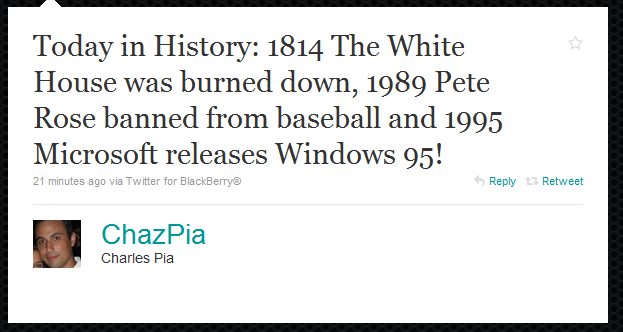Were you in line to buy Windows 95 fifteen years ago?

As a couple of my Twitter buddies have noted, it was 15 years ago today, August 24, that Microsoft launched Windows 95.
I remember exactly where I was on that perfect, blue-sky summer day: I was in the third row inside the tent where Chairman Bill Gates and Jay Leno launched the operating system (to the tune of "Start Me Up.") Outside, on the grounds of the Microsoft Redmond campus, was a full-size ferris wheel. The night before, thousands of people had lined up at Best Buys and other retail stores to buy their copies of Windows 95 at midnight. (As I recall, more than a few in line didn't know what they were lining up to buy, but they queued, figuring it must be something big.)
Gallery: Windows 95 - 15 years later
A whole different cast of characters were in charge of Windows and the newly-launched Internet Explorer 1.0 at the time. Paul Maritz, Jim Allchin and Brad Silverberg were running the show. (Maritz is now heading up Microsoft rival VMware. Allchin has been recording music. Silverberg is one of the founding partners of venture firm Ignition Partners.)
Leading up to the Win95 launch, there were months on end of public and private beta test releases that went out weekly on CDs. I was the Microsoft reporter for PCWeek (now eWEEK) at the time, and my assignment was to write a story about what was in those builds every single week leading up to the release to manufacturing (RTM). It was a challenge (though not an insurmountable one), given I was not one of the sanctioned testers myself.
In 1995 (which also happened to be the year that Microsoft launched Bob, for you Redmond history buffs), Microsoft had $5.9 billion in sales and 17,800 employees. (In 2009, Microsoft reported $62.5 billion in revenues and had about 89,000 employees.) In 1995, Bill Gates was still the President and CEO of the company. The current head of Windows, President Steven Sinofsky, was Director of Program Management for the Office product unit, which was formed in 1994.
Today, the Windows team is in the midst of developing Windows 8. The IE team is prepping the first beta of Internet Explorer 9 (due out September 15). The Windows Live team is continuing to update the betas of the fourth release of Windows Live services -- a collection of software/services that might have actually ended up bundled into Windows had not a number of antitrust watchdogs intervened. And Sinofsky is running the combined Windows/IE/Windows Live organization.
What's changed most of all, in my opinion, in the past 15 years is how Microsoft makes the Windows sausage. There are far fewer public or private test builds of Windows. Instead, the new modus operandi is to make sure features are almost completely baked before letting anyone outside the core team look at or play with a new Windows build. Schedules are meant to be secret and include padding to prevent targeted ship dates from becoming slip dates. Service packs -- even ones that are almost entirely comprised of previously released fixes and updates -- also are subject to the same rules. (Microsoft officials said this summer that SP1 for Windows 7 is due in the first half of 2011, but I can't help but wonder if we might see it sooner, possibly this year.)
Windows -- in spite of Microsoft's best efforts to detangle it via MinWin and other initiatives -- has gotten a lot more complex over the past decade and a half. It has to run on a lot of device types (netbooks, tablets, slates) that didn't really exist back in 1995. It has to work for a billion users who are running everything from 10-plus-year old legacy business apps, to the latest social-networking offerings and games.
We don't know a whole lot yet about Windows 8 -- beyond what has leaked out so far in the form of early planning documents. From that early info, it sounds as though the Windows team understands that it needs to get more serious about making the next release of Windows work well on touch-centric slate devices. The team also seems to be intent on building Windows 8 to be more of a virtualized/virtualizable release, easing backward compatibility and management headaches. We also don't know when Windows 8 will ship, as Microsoft execs still haven't said which year (2011? 2012?) to expect Microsoft to deliver the product.
Whenever Windows 8 does ship, I seriously doubt there will be lines out the door of any brick-and-mortar stores, even Microsoft's own. Most users these days upgrade to a new operating system when they buy it installed on new PCs. With many consumers and business customers choosing to buy new machines now, with Windows 7 installed, will they be in the market, yet again in a couple of years, for another Windows machine? Will slates really evolve to be a completely new category, in between phones and PCs, and become the primary target for Windows 8? Will Windows 8 and its successors become more personal-cloud-centric (whatever that really means)?
Were you one of those in those midnight madness lines 15 years ago? If so, you've seen lots of Windows good, bad and ugly. Do you think the days of the big-bang OS release are over -- or should be --for once and for all?
